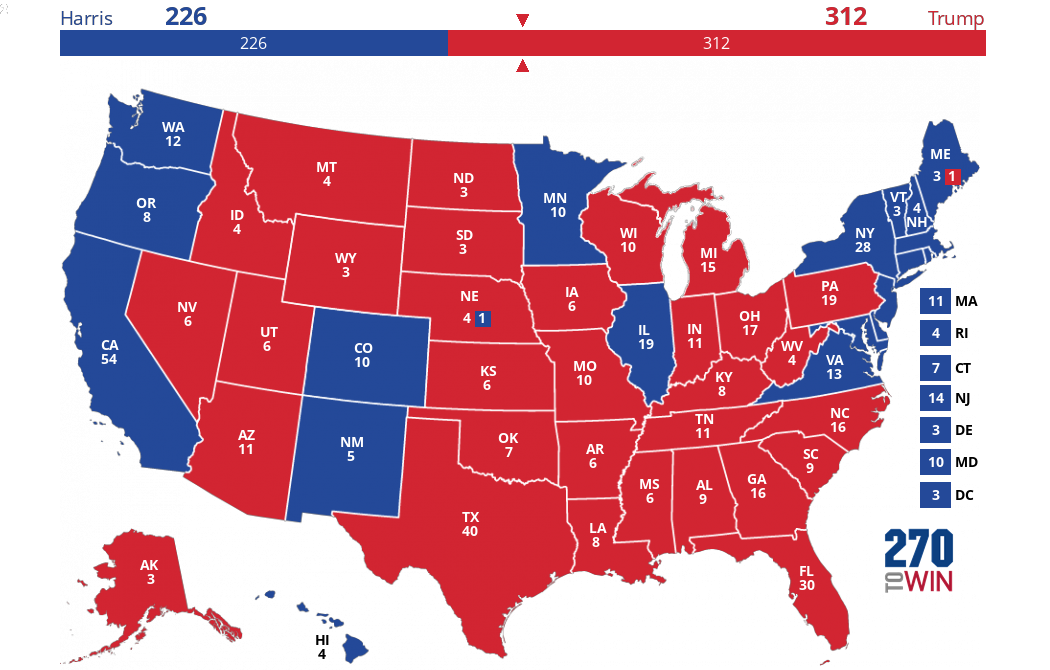March 28 Congressional Redistricting Update
By 270toWin Staff
March 28, 2022, 12:30 PM ET
As Maryland returns to the list after a court ruling, five states have yet to complete congressional redistricting. The Legislature in Florida, Louisiana, and New Hampshire have each passed redistricting bills. However, they have each run into a roadblock from the governor's office.
In Missouri, Republican infighting in the state Senate was finally overcome late last week, with a compromise map emerging. That gets the process going again. With a Tuesday deadline for candidate filing, it is possible the state House acts quickly to get the bill to the governor's desk.
| State (Districts) | Comments |
| Florida (28) | The state is gaining a district. No recent activity. The GOP-controlled Legislature has passed an unusual plan that includes both 'primary' and 'secondary' maps. The major difference is in the treatment of District 5, a Black Opportunity district that stretches across much of the northern part of the state. Gov. Ron DeSantis wants this district made more compact, effectively eliminating the only Democratic-held district north of the Orlando area. The primary map somewhat accedes to this by consolidating the district around Jacksonville. However, it doesn't go as far as DeSantis wants; he has threatened a veto. The secondary map maintains the general shape of District 5 - although makes it slightly less 'blue'. It is intended as a replacement should the primary map be invalidated by the courts as a violation of the Voting Rights Act. |
| Louisiana (6) | On March 9, Gov. John Bel Edwards (D) vetoed the congressional map approved by the Republican-led Legislature. That map largely maintained the status quo. Democrats, led by Edwards, favor the addition of a second majority-minority district given that Blacks now comprise about 33% of the state's population. If the Legislature attempts to override, a 2/3 vote in each chamber is required. |
| Maryland (8) | On March 25, a judge invalidated Maryland's previously enacted map, calling it a Democratic gerrymander in violation of the state Constitution. Overall, the map maintained the 7-1 Democratic edge. However, it shifted the partisan composition of the sole GOP-held seat significantly to the left, potentially putting it into play. |
| Missouri (8) | A deadlock in the Republican-controlled Missouri Senate was finally broken, and that chamber passed a map on March 24. The map maintains the current 6-2 GOP edge. It solidifies the GOP hold on District 2, the only somewhat competitive district in the state in recent cycles. Some conservatives in the Senate had pushed for a more aggressive map that would have 'cracked' Kansas City, giving the GOP a 7-1 edge. The Senate map also included an emergency clause that enables the new map to be effective as soon as it is signed into law - and thus usable for the August 2 primary. The state House is expected to take up the Senate bill during the week of March 28. |
| New Hampshire (2) | Gov. Chris Sununu (R) will veto the congressional map sent to him by the Republican-controlled Legislature. On March 22, he submitted his own plan to the leaders of both legislative chambers. Sununu favors a plan that keeps both districts competitive, while the map approved by the legislature makes each of the state's two districts more partisan. It made District 1 more favorable for a GOP pick-up; the party has not won a U.S. House seat since 2014. |

